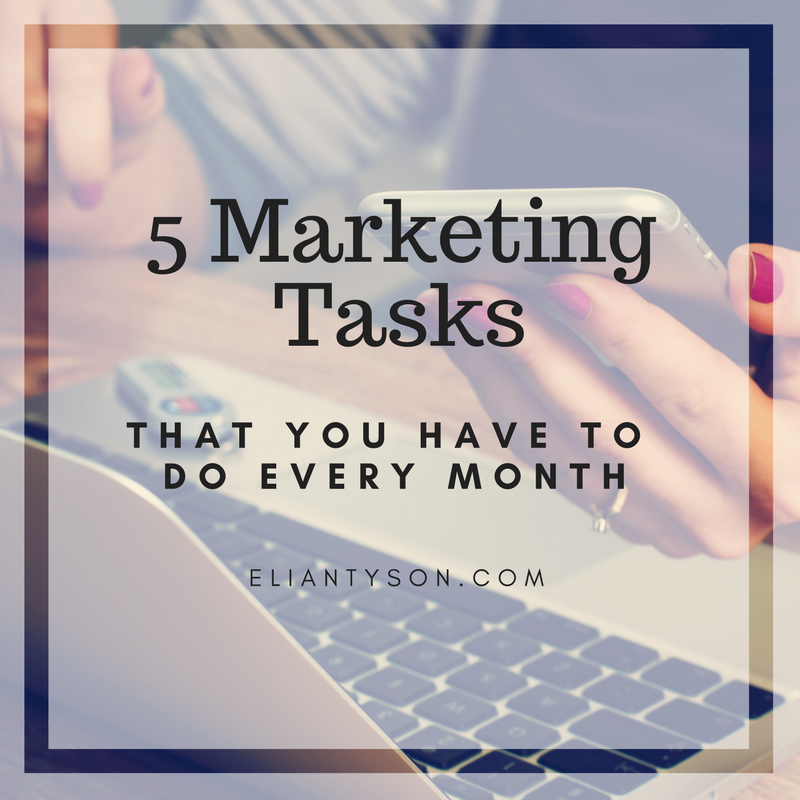There are 5 marketing tasks that you have to do every month for your small business. There is no getting around it.
You need to be thinking about next month (and also the next quarter) right now. If you haven’t been doing this, add planning to your schedule. This is non-negotiable if you are serious about your business growing.
One problem that many small business owners face is they spend time focusing on only one or two tasks from the list below. To get the results you want, you’ve got to do all 5.
Here they are in order.
1. Start with a Plan
First, you must plan. Questions to ask yourself include:
- What are you trying to achieve?
- What are your sales goals for the month?
- What are your sales goals for the quarter?
- What upcoming holidays or events can you tie into for a promotion? Think about what other companies do? If Easter is next month, can you plan a promotion around it or around “spring?”
- Record your stats now so you can compare at the end of the month/quarter/year to tell if you are improving. Things to include:
- Sales (in terms of transactions and revenue)
- Potential customers coming through your door
- Size of your email list
- The number of followers on your different social media channels (e.g., Facebook, Instagram, etc.).
- Number of emails sent
- Number and frequency of social media posts
- Amount of website traffic
- Who is your ideal client? What is your ideal sales path for them? Is there a way to streamline that path and integrate your website into it?
->Get my newest resource Monthly Marketing Tracking form.
2. Social Media
Social media is huge.
I hope that social media has already made a difference in your business. If not, now is a fantastic time to get on board.
If you’re not sure how to make social media work for your business and brand, don’t worry. Help is available.
Generally speaking, different types of customers hang out in different places. So, one of your first jobs is finding out which social networks your prospects and customers prefer. Those sites are where you need to be.
Also, you’ll need to post and share a variety of relevant content to your social media accounts. By “variety,” I mean different types of content (e.g., video, graphics, text) as well as content from different sources (e.g. your original content, user-generated content, and content from industry and media sources).
Important: Make sure that you don’t always use your social media profiles to pitch sales. Instead, focus on adding value to your target market.
As a rule, 7 or 8 out of every 10 of your social media post should be focused on educating, informing and entertaining your audience. Only 20 or 30% of your content should involve promotions and specials.
3. Advertising
Advertising is always important.
Depending on your market, the amount of money you spend on advertising can vary. For many businesses, advertising is the largest part of their marketing budget.
If you’re in a small town you may have some less expensive options than those found in larger markets. This can happen because you have fewer competitors.
Regardless, one of your challenges will be tracking the performance of each of your advertising channels.
For example, if you rent a billboard, make sure it displays a special phone number or website address or keyword or unique call to action. That way, you can track the number of incoming contacts that it generates.
Measuring the results of all your advertising will help you make better decisions on future advertising options that are most profitable for your business.
Here are a few more important advertising tips:
- Make sure your signage is large and easy to read.
- Consider direct mail campaigns. Did you know you can send postcards and other materials to a particular street or neighborhood? The are many affordable options from the post office might surprise you.
- Paid social media advertising is affordable and effective. For instance, on Facebook, you can precisely define who gets to see your ads, helping you to get the most “bang” for every dollar you spend.
- You can also advertise on Google. Again, you can define your audience and set your budget.
Caution: You may discover that online advertising is confusing at first. I can help!
4. Email
Always work on building your email list. This gives you a way to stay connected with your audience while pushing leads and prospects through your sales funnel. Also, your email list can help you build customer loyalty and repeat sales.
If you have folks coming into your shop, get their email address, but don’t stop there! Send them something.
You don’t have to worry about sending out sophisticated, beautiful emails. Instead, just send out a weekly note. If you don’t know what to say, simply share some of your social media or website content with your list. Also, encourage your recipients to follow you on social media.
Every time you send an email, make sure it has a call to action (CTA). This could be as simple encouraging people to reply to your message or inviting them to view a particular page on your website.
Do everything you can to keep people engaged with your brand. For example, have challenges and contests that make people want to interact.
Also, try to make your audience feel special. To do this, you could give your list a special name such as your “VIP list”. People will want to join so they’re the first to know new things about your business and products. If you have a restaurant and you already have daily specials, this is a great way to share them 😊.
5. Review
At the end of every month, you need to analyze what worked and what didn’t.
Avoid quitting too soon on your ideas. Most likely you will need to give a tactic 2-3 months of consistent effort to show results.
Meanwhile, get some feedback from employees or friends on what they liked and didn’t like about your business and marketing campaigns. Use that feedback to make positive changes for the coming month.
Online, take your posts that were well received and use them as guidelines for future posts. Similarly, take note of the posts that got little or no traction and avoid those topics or formats in the future.
Need some help?
I’m in the process of developing guides and “how to” articles on a variety of business building topics for small business owners. Let me know which topic you’d like to learn more about first.
Be sure to get my newest resource Monthly Marketing Tracking form.



